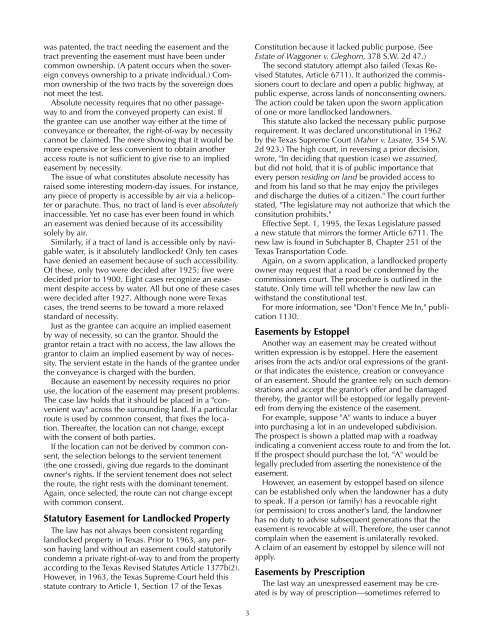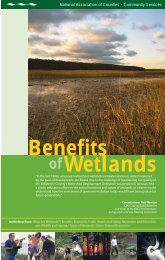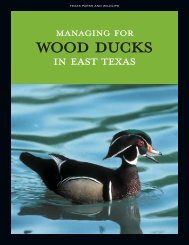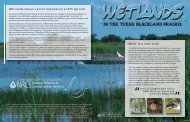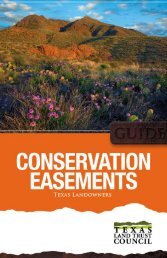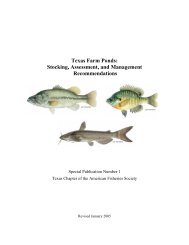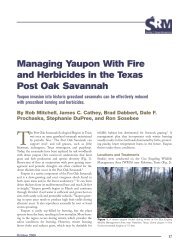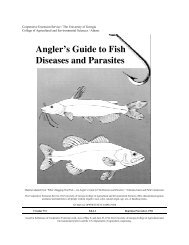Easements in Texas - Real Estate Center - Trinity Waters
Easements in Texas - Real Estate Center - Trinity Waters
Easements in Texas - Real Estate Center - Trinity Waters
- No tags were found...
You also want an ePaper? Increase the reach of your titles
YUMPU automatically turns print PDFs into web optimized ePapers that Google loves.
was patented, the tract need<strong>in</strong>g the easement and thetract prevent<strong>in</strong>g the easement must have been undercommon ownership. (A patent occurs when the sovereignconveys ownership to a private <strong>in</strong>dividual.) Commonownership of the two tracts by the sovereign doesnot meet the test.Absolute necessity requires that no other passagewayto and from the conveyed property can exist. Ifthe grantee can use another way either at the time ofconveyance or thereafter, the right-of-way by necessitycannot be claimed. The mere show<strong>in</strong>g that it would bemore expensive or less convenient to obta<strong>in</strong> anotheraccess route is not sufficient to give rise to an impliedeasement by necessity.The issue of what constitutes absolute necessity hasraised some <strong>in</strong>terest<strong>in</strong>g modern-day issues. For <strong>in</strong>stance,any piece of property is accessible by air via a helicopteror parachute. Thus, no tract of land is ever absolutely<strong>in</strong>accessible. Yet no case has ever been found <strong>in</strong> whichan easement was denied because of its accessibilitysolely by air.Similarly, if a tract of land is accessible only by navigablewater, is it absolutely landlocked? Only ten caseshave denied an easement because of such accessibility.Of these, only two were decided after 1925; five weredecided prior to 1900. Eight cases recognize an easementdespite access by water. All but one of these caseswere decided after 1927. Although none were <strong>Texas</strong>cases, the trend seems to be toward a more relaxedstandard of necessity.Just as the grantee can acquire an implied easementby way of necessity, so can the grantor. Should thegrantor reta<strong>in</strong> a tract with no access, the law allows thegrantor to claim an implied easement by way of necessity.The servient estate <strong>in</strong> the hands of the grantee underthe conveyance is charged with the burden.Because an easement by necessity requires no prioruse, the location of the easement may present problems.The case law holds that it should be placed <strong>in</strong> a "convenientway" across the surround<strong>in</strong>g land. If a particularroute is used by common consent, that fixes the location.Thereafter, the location can not change, exceptwith the consent of both parties.If the location can not be derived by common consent,the selection belongs to the servient tenement(the one crossed), giv<strong>in</strong>g due regards to the dom<strong>in</strong>antowner's rights. If the servient tenement does not selectthe route, the right rests with the dom<strong>in</strong>ant tenement.Aga<strong>in</strong>, once selected, the route can not change exceptwith common consent.Statutory Easement for Landlocked PropertyThe law has not always been consistent regard<strong>in</strong>glandlocked property <strong>in</strong> <strong>Texas</strong>. Prior to 1963, any personhav<strong>in</strong>g land without an easement could statutorilycondemn a private right-of-way to and from the propertyaccord<strong>in</strong>g to the <strong>Texas</strong> Revised Statutes Article 1377b(2).However, <strong>in</strong> 1963, the <strong>Texas</strong> Supreme Court held thisstatute contrary to Article 1, Section 17 of the <strong>Texas</strong>Constitution because it lacked public purpose. (See<strong>Estate</strong> of Waggoner v. Gleghorn, 378 S.W. 2d 47.)The second statutory attempt also failed (<strong>Texas</strong> RevisedStatutes, Article 6711). It authorized the commissionerscourt to declare and open a public highway, atpublic expense, across lands of nonconsent<strong>in</strong>g owners.The action could be taken upon the sworn applicationof one or more landlocked landowners.This statute also lacked the necessary public purposerequirement. It was declared unconstitutional <strong>in</strong> 1962by the <strong>Texas</strong> Supreme Court (Maher v. Lasater, 354 S.W.2d 923.) The high court, <strong>in</strong> revers<strong>in</strong>g a prior decision,wrote, "In decid<strong>in</strong>g that question (case) we assumed,but did not hold, that it is of public importance thatevery person resid<strong>in</strong>g on land be provided access toand from his land so that he may enjoy the privilegesand discharge the duties of a citizen." The court furtherstated, "The legislature may not authorize that which theconsitution prohibits."Effective Sept. 1, 1995, the <strong>Texas</strong> Legislature passeda new statute that mirrors the former Article 6711. Thenew law is found <strong>in</strong> Subchapter B, Chapter 251 of the<strong>Texas</strong> Transportation Code.Aga<strong>in</strong>, on a sworn application, a landlocked propertyowner may request that a road be condemned by thecommissioners court. The procedure is outl<strong>in</strong>ed <strong>in</strong> thestatute. Only time will tell whether the new law canwithstand the constitutional test.For more <strong>in</strong>formation, see "Don't Fence Me In," publication1130.<strong>Easements</strong> by EstoppelAnother way an easement may be created withoutwritten expression is by estoppel. Here the easementarises from the acts and/or oral expressions of the grantorthat <strong>in</strong>dicates the existence, creation or conveyanceof an easement. Should the grantee rely on such demonstrationsand accept the grantor’s offer and be damagedthereby, the grantor will be estopped (or legally prevented)from deny<strong>in</strong>g the existence of the easement.For example, suppose "A" wants to <strong>in</strong>duce a buyer<strong>in</strong>to purchas<strong>in</strong>g a lot <strong>in</strong> an undeveloped subdivision.The prospect is shown a platted map with a roadway<strong>in</strong>dicat<strong>in</strong>g a convenient access route to and from the lot.If the prospect should purchase the lot, "A" would belegally precluded from assert<strong>in</strong>g the nonexistence of theeasement.However, an easement by estoppel based on silencecan be established only when the landowner has a dutyto speak. If a person (or family) has a revocable right(or permission) to cross another's land, the landownerhas no duty to advise subsequent generations that theeasement is revocable at will. Therefore, the user cannotcompla<strong>in</strong> when the easement is unilaterally revoked.A claim of an easement by estoppel by silence will notapply.<strong>Easements</strong> by PrescriptionThe last way an unexpressed easement may be createdis by way of prescription—sometimes referred to3


